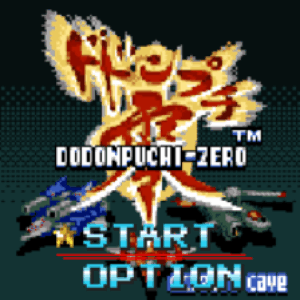 Dedication and perseverance have led us to this fortuitous moment: DoDonPuchi Zero is playable for everyone after having been locked to archaic Japanese mobile phones for two full decades! This is simply incredible news to those of us who follow these things, but for many who’d never even heard of this, understand this is a landmark moment. Wherever you’re coming from, I’d like to share the history of the game, the platform and what’s so special about this ‘tiny’ entry into the DonPachi franchise.
Dedication and perseverance have led us to this fortuitous moment: DoDonPuchi Zero is playable for everyone after having been locked to archaic Japanese mobile phones for two full decades! This is simply incredible news to those of us who follow these things, but for many who’d never even heard of this, understand this is a landmark moment. Wherever you’re coming from, I’d like to share the history of the game, the platform and what’s so special about this ‘tiny’ entry into the DonPachi franchise.
The mobile market in the West in 2003 was understandably limited, however, in Japan, things were bustling. Publishers innumerable were developing and porting existing IPs to the mobile realm in the form of a diverse and curious rainbow of titles. From a preservation vantage point, this is one of the most-prolific yet least-documented era in gaming. Capcom, for instance, issued no fewer than a dozen mobile-only games using their existing IPs: Rockman, Street Fighter, Vampire/Darkstalkers as puzzle titles, card games, rhythm experiments and much more with virtually none of these available in any form in 2025. I digress; let’s step back and look at how things all began and how shmups fit into the whole story.
History of Cave’s Mobile Titles
Starting in 1999, the Japanese company NTT DoCoMo began offering a service called i-mode which allowed mobile phones to go online. This primitive service offered web access and e-mail, initially in monochrome environments, before developers began to expand into the gaming realm.
On the 17th of September, 2002, CAVE launched their own storefront titled The シューティング ゲーセン横 (The Shooting Game Center Yokocho) for i-mode compatible phones. The site had four sections: Arcade Game Information, Classic Games, Variety Games and Score Trial. Classic titles were 1990s-era CAVE and Psikyo games like Strikers 1945 and Gunbird. Variety Games housed the pinball spin-offs ESP Pinball and DonPin (another game we know only from screenshots), some puzzle and strategy games, and today’s topic: DoDonPuchi Zero.
The service cost ¥300 a month (about $2 USD today) to access. For this fee, you’d receive six credits. Classic games cost three points and Variety two, but if you deleted it from your phone, you’d receive one credit back. Participating in the Score Attack cost one credit itself.
By the following year, the company had published several mobile renditions of their popular titles, including ports of Dangun Feveron, DoDonPuchi (not Zero), ESP Ra.De and Ketsui. All in all, CAVE published about two dozen games on the services, sometimes in split form, due to storage and bandwidth restrictions. DoDonPuchi Zero, by contrast, was an original game developed exclusively for the 504i series of phones and is the subject of today’s deep dive.
Game Center Yokocho shut down in 2014 and after that point, the only way to play these games was by finding a phone with the title still installed. Due to preservation efforts by RockmanCosmo and the excellent Keitai World Launcher, we’ve seen scores of otherwise-inaccesible titles made available in recent years. I wrote about the astonishing preservation of DoDonPachi: Dai-Ou-Jou Reco.Ver a few weeks ago, and we now can play yet-another long-lost entry: DoDonPuchi Zero with special thanks to Cuebus for dumping this (and for not getting one credit back by deleting the game!!!) In the process, he also preserved a trial version of DoDonPuchi proper; information about that rendition will be saved for its own entry. For now, let’s dive into exactly what DDPZ is, a sentence I’ve wished to utter since learning of this game in the early ‘00s.
ドドンプチ零 / DoDonPuchi Zero
One of CAVE’s earliest entries into their service was DoDonPuchi Zero, an original game “created by the arcade game staff,” Furukawa recalled in a 2020 interview with 4Gamer. He continued, “it established a mobile shooter engine, so in that sense it was a very valuable title.” Rather than just translating existing code, this was an important step for the company, who would issue renditions of Mushihimesama, Pink Sweets, ESP Galuda (both 1 and 2), Storm Of Progear and more in the coming years.
The Zero suffix was not uncommon for Japanese titles, but its full name was a fun take on the already jovial DoDonPachi. It’s long been established that the title DonPachi and DoDonPachi each contain a play on words: the first entry roughly means Bee Leader and the sequel Angry Bee Leader all while hearkening the onomatopoeic sound of gunfire. Here, Puchi translates to ‘petite’ or ‘mini’, making this an Angry Mini Bee – more or less. It’s playful and fitting.
 |
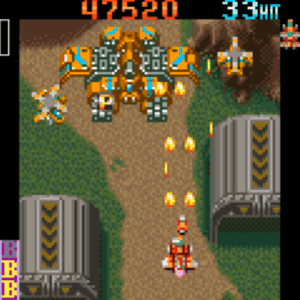 |
Audio & Music
Given the truly-limited storage size of games on this platform (DDPZ clocks in at a meager 31k), there are no sound effects. However, the legendary Manabu Namiki was hired to do the soundtrack, quite surprising, given his pedigree and the nature of this title. He recalled in a 2010 interview of STG Gameside #1 (with special thanks to Shmupilations for the translation.)
Interviewer:
What shooting game music you’ve composed has given you a lot of troubles, or is otherwise very memorable for you?Namiki:
The work I did for the mobile phone app DoDonPuchi Zero gave me a lot of problems. The available memory was tiny, and there wasn’t enough space for the BGM data, so there was no way to get it to fit except for removing notes from the songs. Even though I had to shave off so many notes from the pieces, the songs still needed to be enjoyable to listen to, and with all the fine tuning I had to do on these songs it was like some incredibly complex puzzle. Those days remind me of how much I hated the way musical data was done on mobile devices. (laughs)
Each stage’s theme song is a bit over a minute long and with the levels themselves lasting about two, the loop is enjoyable and not too repetitive. Though Namiki was understandably frustrated with the constraints and results, the songs are actually quite catchy, despite not drawing from the original DDP’s tunes at all. Boss music is shared and there is a pair of other tracks: the intro/ship select music and the usual end-of-level quick recap as well. See the Links Section below for a download of the full OST.
 |
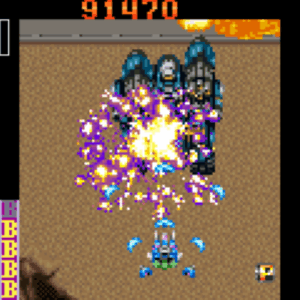 |
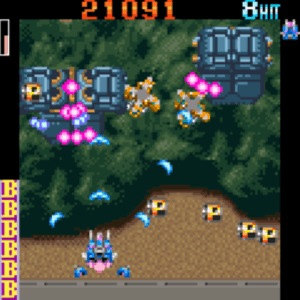 |
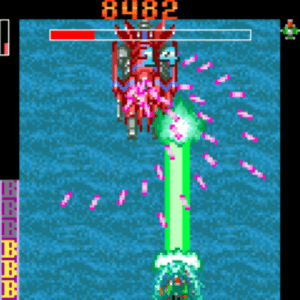 |
The Game Itself
The fact that DDP Zero was an original game makes this a unique entry amongst the standard fare of ported titles. While this diminutive version was scaled down considerably, so much of the base game was carried over here. The core gameplay was the same: Three ships, laser or shot choices. Bombs came in the same two flavors. A warning sign flashes before each boss and afterwards, your star count is tallied, distributing a bonus for a No Miss.
For a stripped-down mobile title from 2003, DDPZ was a surprisingly-good game! There are three difficulty levels and you could change your ship speed in the options menu. There was an online leaderboard as you could upload scores, but while this is all impressive, do not forget that this was a mobile-phone game. On the numberpad, you moved with the number keys, 0 would change from laser to shot and # would unleash bombs. It’s actually more playable today with proper controller configurations (much like the G-Mode ports).
Each of the three ships does feel unique and represents the pedigree of the series well. Two stages are available and you can begin on stage 2 when starting. Entering level 1, it’s astonishing just how well the game actually runs. It’s smooth and features a fair amount of bullets, particulary for the 240×240 screen. The added difficulties present even-more firepower to dodge and the game scrolled fluidly, even with all these on-screen projectiles.
Both stages have a mid-boss with a life bar and you could destroy the arms of the second-stage boss, revealing a more-difficult bullet pattern. Even the chaining system arrives intact, carrying over the GP meter in the upper-left-hand corner and the usual dance of popcorn enemies, lasering tougher foes, revealing bees via said laser and harsh scoring punishments for bombing.
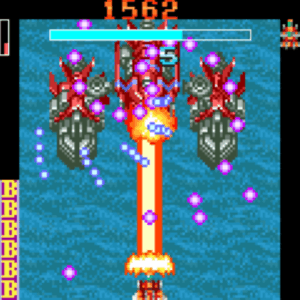 |
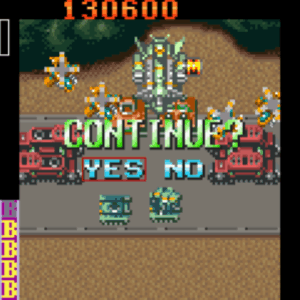 |
 |
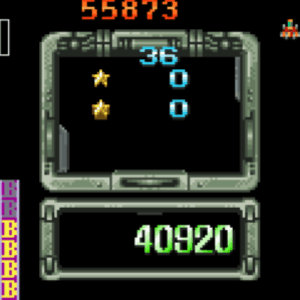 |
Final Thoughts
DoDonPuchi Zero is, by all accounts, a mere novelty when compared to even console affairs of the time. However, it is a fun and competent representation of the best shooting series ever produced.
A trio of CAVE’s mobile DX games were ported to the Switch and Steam by G-Mode with great results and it would be phenomenal to see others get the same treatment. It seems unlikely, but this preservation effort should be applauded and I sincerely hope the momentum continues as there are so many unique and quirky entries into our favorite franchises that many of us have never played. I hope these chronicles covering such niche titles are worthwhile to some. Thanks for reading!
Useful Links
- Keitai Archive (Emulator link)
- Superb Shooting (JPN: Full list of Yokocho games & info)
- Keitai Wiki (Entry for Game Center Yokocho)
- YouTube: Type-A Hard 1CC (From STG-SLK)
- Soundtrack Rip (FLAC & 320kbps MP3 – 29Mb ZIP)
- BeeStorm (My DoDonPachi site)